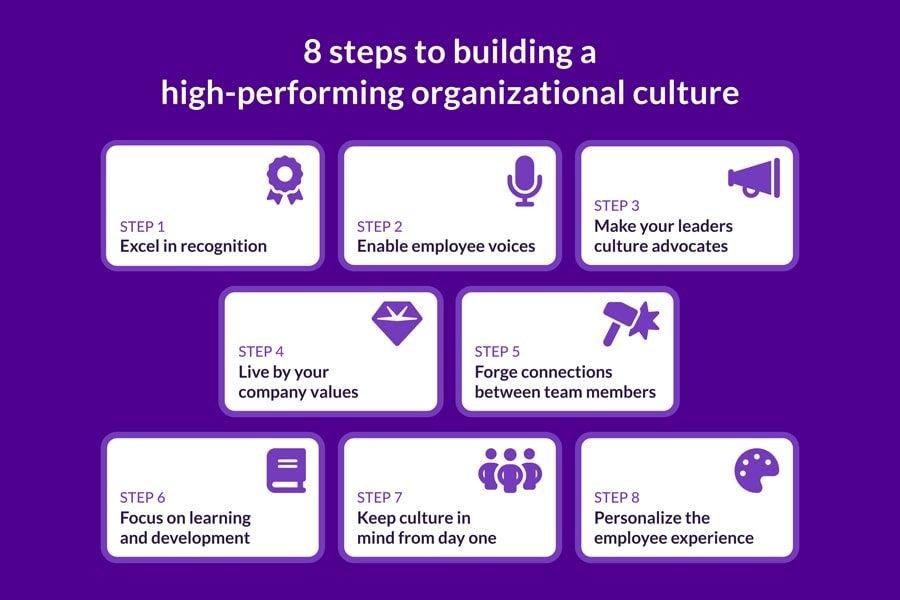📚 Unlock the World of AI and Humanity with These Two Free Books! 🚀
Dive into the thrilling realms of artificial intelligence and humanity with "The ECHO Conundrum" and "Awakening: Machines Dream of Being Human". These thought-provoking novels are FREE this week! Don't miss the chance to explore stories that challenge the boundaries of technology and what it means to be human.
Read More & Download
Organizational culture is the bedrock of any successful business. It shapes employee behavior, influences customer perception, and ultimately impacts the bottom line. Companies with thriving cultures are 1.5 times more likely to see revenue growth of 15% or more over three years and 2.5 times more likely to experience significant stock growth in the same period. Despite this, many organizations struggle to cultivate the culture they need. This guide provides a roadmap to building a high-performing organizational culture that fuels success.
 two employees bumping fists in an office meetingA vibrant workplace culture fosters collaboration and celebrates success.
two employees bumping fists in an office meetingA vibrant workplace culture fosters collaboration and celebrates success.
Why is Organizational Culture Important?
Organizational culture encompasses the shared values, beliefs, attitudes, systems, and behaviors within a company. It’s the invisible force that guides how employees interact, make decisions, and approach their work. A strong organizational culture isn’t just about creating a “fun” workplace; it’s a crucial driver of business performance. Here’s why:
- Talent Acquisition: 77% of job seekers consider a company’s culture before applying. A positive culture acts as a magnet for top talent.
- Employee Retention: Culture is a primary reason why 65% of employees stay in their jobs. A strong culture fosters a sense of belonging and loyalty.
- Brand Identity: A company’s culture directly influences its brand image. A positive internal culture often translates to a positive external perception.
- Employee Engagement: Companies with positive cultures report up to 72% higher employee engagement. Engaged employees are more productive, creative, and committed.
From daily interactions to long-term strategies, organizational culture permeates every facet of a business. When employees feel aligned with the company’s values, they are more likely to be productive, innovative, and committed to the organization’s success.
Qualities of a Thriving Organizational Culture
While every organization’s culture is unique, high-performing cultures consistently exhibit certain key qualities:
Alignment
Alignment occurs when the company’s objectives and employee motivations are in sync. Organizations should strive for continuous alignment with their vision, purpose, and goals.
Appreciation
A culture of appreciation fosters a positive and supportive work environment. Regular recognition and thanks for employee contributions are essential.
Trust
Trust is the cornerstone of any healthy relationship, including those within a workplace. A culture of trust allows team members to express themselves openly and rely on each other.
 Organizations Creating a Culture of TrustTrust is the foundation of a strong and collaborative team.
Organizations Creating a Culture of TrustTrust is the foundation of a strong and collaborative team.
Performance
A culture that values performance motivates employees to excel and achieve ambitious goals. This focus on results drives greater profitability and productivity.
Resilience
In today’s dynamic business environment, resilience is crucial. A resilient culture equips leaders and employees to adapt to change and overcome challenges.
Teamwork
Teamwork thrives on collaboration, communication, and mutual respect. When team members support each other, they achieve more and experience greater job satisfaction.
Integrity
Honesty and transparency are the hallmarks of a culture with integrity. This fosters trust and accountability among team members.
Innovation
A culture of innovation encourages creative thinking and the exploration of new ideas. This fosters continuous improvement and adaptability.
Psychological Safety
Psychological safety empowers employees to take risks, share ideas, and provide honest feedback without fear of negative consequences.
8 Steps to Building a High-Performing Culture
Building a strong organizational culture requires a deliberate and sustained effort. Here’s an eight-step roadmap:
 8 steps to building a high performing organizational cultureA strategic approach to culture building ensures long-term success.
8 steps to building a high performing organizational cultureA strategic approach to culture building ensures long-term success.
1. Excel in Recognition
Recognize and reward employee contributions frequently. Tie recognition to company values and specific actions to reinforce desired behaviors.
📚 Unlock the World of AI and Humanity with These Two Free Books! 🚀
Dive into the thrilling realms of artificial intelligence and humanity with "The ECHO Conundrum" and "Awakening: Machines Dream of Being Human". These thought-provoking novels are FREE this week! Don't miss the chance to explore stories that challenge the boundaries of technology and what it means to be human.
Read More & Download
2. Enable Employee Voice
Create channels for employees to share feedback openly. Actively listen to employee concerns and act on their suggestions.
 Enabling Culture of Employee VoiceOpen communication and feedback are essential for a healthy culture.
Enabling Culture of Employee VoiceOpen communication and feedback are essential for a healthy culture.
3. Make Leaders Culture Advocates
Leaders should embody the company’s values and actively promote the desired culture through their words and actions.
4. Live by Your Company Values
Integrate company values into every aspect of the business, from HR policies to customer interactions. Ensure that values are more than just words on a wall.
5. Forge Connections Between Team Members
Encourage collaboration and team-building activities to foster strong relationships among employees.
 Building Team Connections in your OrganizationStrong team connections are crucial for a supportive and collaborative work environment.
Building Team Connections in your OrganizationStrong team connections are crucial for a supportive and collaborative work environment.
6. Focus on Learning and Development
Invest in employee growth through training, coaching, and development opportunities. This demonstrates a commitment to employee success.
7. Keep Culture in Mind From Day One
Integrate culture into the hiring and onboarding process. Ask culture-fit questions during interviews and reinforce values during onboarding.
 Building Teamwork as a Part of CultureTeamwork is a fundamental element of a thriving organizational culture.
Building Teamwork as a Part of CultureTeamwork is a fundamental element of a thriving organizational culture.
8. Personalize the Employee Experience
Tailor the employee experience to individual needs and preferences. Use tools like pulse surveys to understand what employees value and create personalized development plans.
Conclusion
Building a high-performing organizational culture is an ongoing journey, not a destination. By focusing on communication, recognition, and action, organizations can create a culture that attracts top talent, fosters employee engagement, and drives business success. Implementing these eight steps will help create a thriving culture that benefits both employees and the organization as a whole.
FAQ
What are examples of organizational culture?
Examples include a company’s interview process, commitment to diversity, equity, and inclusion (DE&I), and employee wellness initiatives.
Why is changing organizational culture important?
Changing culture can help a business stay competitive, attract talent, innovate, and create a positive work environment.
Can an organization change its culture?
Yes, but it takes time, leadership support, and a human-centric approach reflected in all organizational practices.
How does changing organizational culture affect employees?
Employees adopt new behaviors, attitudes, and work ethics aligned with the organization’s desired goals and values.
How does leadership influence organizational culture?
Leaders shape culture through their actions and reactions, setting an example for employees.
Why do different organizations have different cultures?
Different leadership styles, values, and industry contexts contribute to varying organizational cultures.
What are the 4 main types of organizational culture?
- Clan Culture: Collaborative and supportive.
- Adhocracy Culture: Innovative and risk-taking.
- Market Culture: Results-oriented and competitive.
- Hierarchy Culture: Structured and process-driven.
📚 Unlock the World of AI and Humanity with These Two Free Books! 🚀
Dive into the thrilling realms of artificial intelligence and humanity with "The ECHO Conundrum" and "Awakening: Machines Dream of Being Human". These thought-provoking novels are FREE this week! Don't miss the chance to explore stories that challenge the boundaries of technology and what it means to be human.
Read More & Download

